This site comes as a complement to the amazing Speidel Braumeister by providing the most complete, yet super easy to follow, instructions on How to brew with the Speidel Braumeister
This guide is the result of countless brews by a passionate owner, with many hints learnt through experience
So, let’s get started!
Ideally, place your Braumeister right next to a source of hot water, like a shower, and a drain (bathtub, sink or just a hole in the ground), which will make your entire brew day much easier
Weigh your malts and crush them if needed
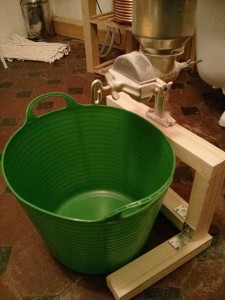
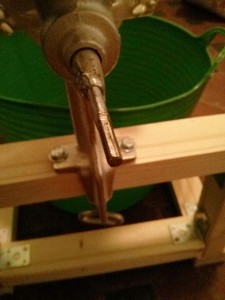

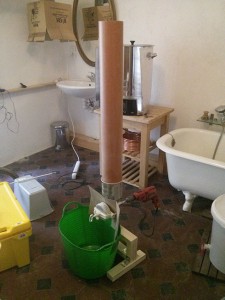

Prepare 4L (1 gallon) of sanitizer in a bucket, that’s about 5ml of Star San or 15g (1/2oz) of sanitizing powder such as One Step
Doublecheck that the pump of the Braumeister is properly tightened
Clean the Braumeister like this:
- Rinse the inside
- Activate the pump
- Drain through the spigot
Repeat if needed
Make sure the pump is powerful and free from malt from previous brews
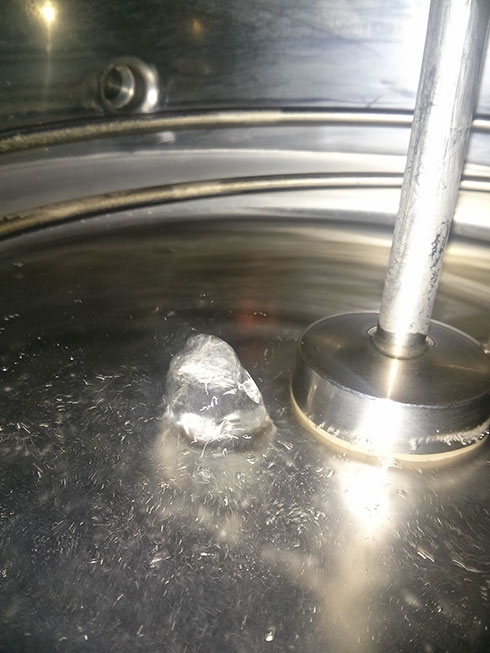
Place the malt pipe, as well as one perforated disc at the bottom and a fine mesh disc on top of it
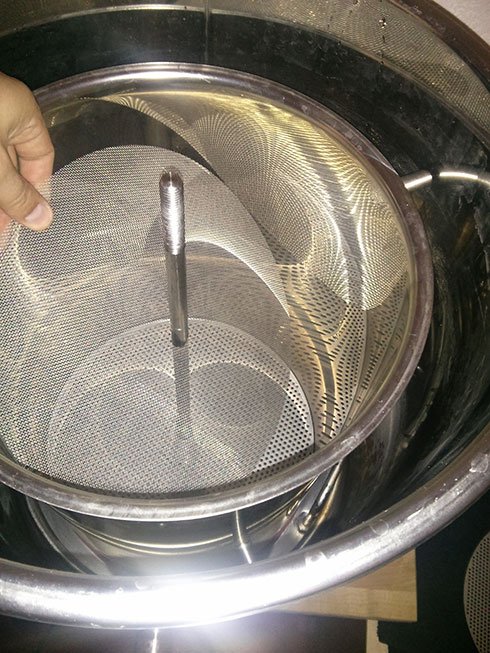
Mash
Turn your Braumeister on and make sure the recipe is correctly programmed
Start the program making sure you are on the right recipe
- Dough-in: 60°C (140°F)
Starting at 60°C (140°F) instead of 38°C (100°F) allows for a much easier cleaning - Mash in (saccharification rest): 67°C (152°F) for 60 minutes
- Mash out: 77°C (170°F) for 5 minutes
- Boil: 98°C (208°F) for 60 minutes
This slightly lower boil temp gives the perfect rolling boil with less risk of a boil over
Hop additions according to the recipe
If you need the Braumeister equipment and mash profiles for BeerSmith, you will find them here
There’s also great information on how to program BeerSmith for the Braumeister here (Nesto’s reply)
If you need recipes, check our page Braumeister Recipes, where you will also find more information about more advanced mash steps
If you correct your water, it’s time to add lactic or phosphoric acid
More info
Water by John Palmer | Bru’n Water | EZ Water Calculator
Fill with 23L mash water (the top mark is 25L and the one below 20L, so that’s a little higher than halfway between the two)
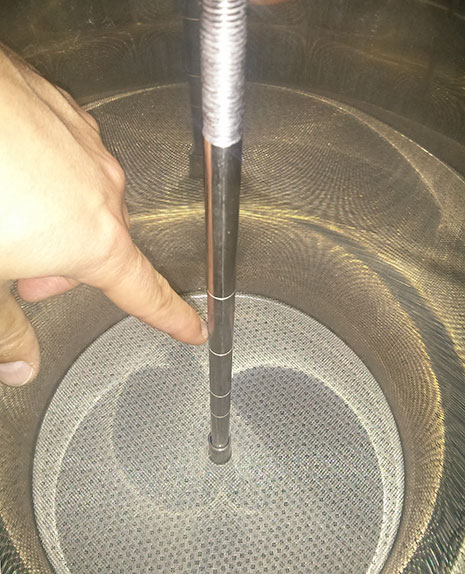
As you fill the Braumeister, keep an eye on the display and adjust the shower (if any) for approx. 60°C (140°F), starting at this slightly higher temperature, 60°C (140°F) instead of 38°C (100°F), prevents sugars from sticking onto the coil during dough-in and makes cleaning a bliss, without any difference on the beer taste
Pour the malt into the pipe taking great care not to drop grain outside the pipe, which could clog the pump


Place the top fine mesh disc and the perforated disc on top of it, and secure them with the tube and wing screw
Install the insulation thermocollar if any. You can use a foam camping pad with aluminum lining as a cheaper alternative
More info about Braumeister insulation
Put the lid on
If you want to measure the mash pH, do it 15 minutes into the first mash step
You can set an alarm on your phone for this
Let the wort cool down in a cup before measuring if you use a pH meter, those devices are easily damaged by high temperatures
Mash pH after 15 minutes should be between 5.2 and 5.4 and it’s a very important factor for optimal conversion of starch into sugar

The Braumeister will go through both mash and mash out automatically without stopping, until it will beep to ask you to remove the pipe
That’s about 1.5 hour with the above program
Feel free to open a window from now on to let steam and smell escape
You can already prepare your hops additions during the mash

Sparge
When the Braumeister beeps to asks you to remove the pipe, start the rest of the program immediately (= 3 clicks), as it will take a good 15 minutes to reach a boil anyway
Lift the pipe and, without removing the perforated disc, sparge about 3L of hot water (77°C/170°F) on top of it, that’s about up to its little cylinder handle
Your simplest bet for this is to use a shower at max temperature ~65°C (149°F)

Let the pipe drain for 2 minutes and then move it on top of your fermentation bucket the same way it was sitting on the Braumeister
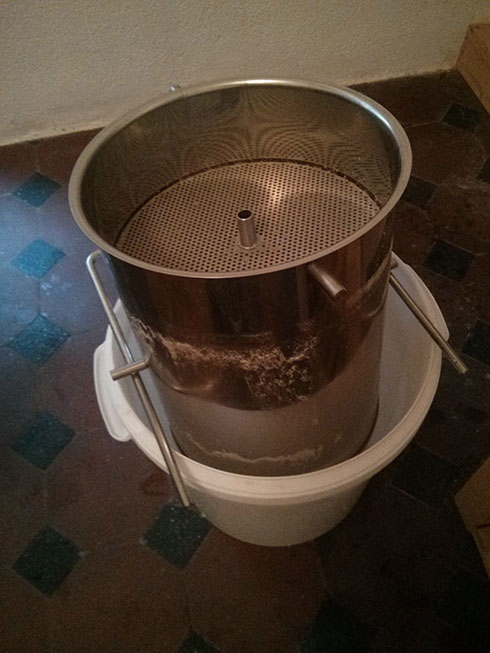
Don’t forget to add hot water to the Braumeister up to 24.5L (right below the top mark on the central piece), that will be your pre-boil volume
If you typically brew 5 Gal (19L) recipes you found online, this means 5 Gal in the bottles/keg
To reach this goal with your 20L Braumeister, start with a pre-boil vol of 6.5 Gal (24.5L), so that you will end up with about 5.4 Gal (20.5L) in the fermenter
This way, when you bottle, with the trub loss, you will end up with your 5 Gal (19L)
In case of a 90 minutes boil, start with 6.7 Gal (25.5L)
By the way, boiling for 90 minutes does not make much difference, unless a special hops schedule is required by the recipe, so, go for 60 minutes, you will save time
Starting with these pre-boil volumes is a great way to go, especially for brewers in the metric system, because you can directly recycle the many 5 Gal recipes you find online without any further conversion
If you want to speed up the temperature rise, you can use a 2000W portable water heater, which allows to reach a boil in 7-8 minutes instead of 15
Note: on a 220V 10A network, this might blow your fuse, but worry not, even if after a power cut, your Braumeister will be able to resume the program
Measure the pre-boil gravity
Your best bet for this is a refractometer
Pour the wort you collected in the bucket into the Braumeister
Boiling 25L of wort for 60 minutes creates quite some steam (not to mention 90 minutes) and you may want to extract this outside to make sure it won’t start dropping from the ceiling, which could create a risk of contamination
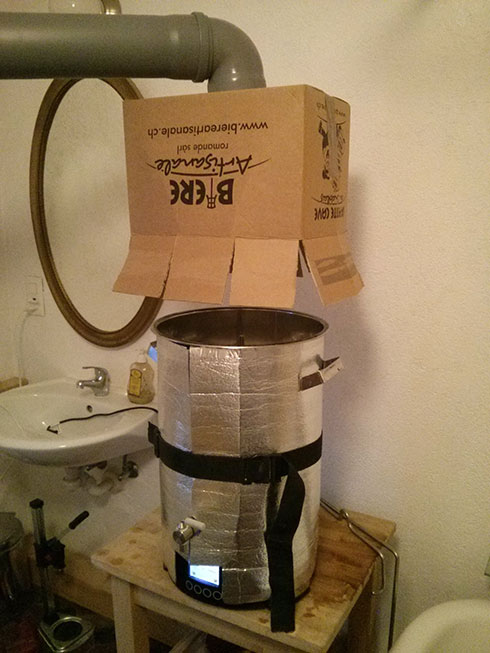

Boil
When the boil starts, remove the lid, so that off-flavors can be released
Add bittering hops
The first hop addition will likely end up on the sides of the kettle because of the hot break (foam), feel free to scrub and push them down with a plastic paddle
Dump the grain into the bucket and discard it
You can keep some to make dog treats as per this recipe

For “ruffly” 30 pieces
- 6 cups spent grain
- 385g flour (3 cups)
- 400g peanut butter (1.5 cup)
- 3 eggs
Mix everything in a large salad bowl
Make 5cm (2 in) diameter balls and then flatten them down to 1cm (1/2 in) and make the bone shapes
Preheat oven to 175°C (350°F), then bake for 30 minutes
Lower temperature down to 107°C (225°F) and let dry for 3 hours if not more
Keep in the fridge in a sealed container
Also, clean the pipe and discs before things gets sticky
Add flavoring and aromatic hops at given times according to the recipe
Cool wort down
Prepare your wort chiller and place it in the Braumeister 10 minutes before the end of the boil to sanitize it

Sanitize your fermenter
More about Braumeister fermenters
Remove the insulation thermocollar if any and plug your sink or other tank if you want to recover the warm water from the wort chiller for later cleaning, which is very handy
Do not unplug the Braumeister, as you will need its thermometer during the cooling
Start chilling the wort
When you reach yeast pitching temperature 21°C (70°F), measure Original Gravity (OG)
Pitch yeast in the fermenter before transferring the wort, this way it will naturally get mixed and not remain stuck in the foam in case you use an aerator
It’s a good idea to place a strainer bag in the fermenter (after the yeast), because, even with a proper whirlpool, a lot of hops will make it to the fermenter and this can affect the bitterness of your beer

Open the spigot making sure it splashes as much as possible for better oxygenation
Towards the end, you can tilt the kettle, but stop when it’s almost only hops
If you use a wort aerator, put it in the fermenter for 10 minutes while you clean the Braumeister
Take note of your batch size (that’s the volume of wort in the fermenter)
Finally, in your favorite calendar, add the various remaining operations:
- Check fermentation (24-48h)
- Rack to secondary fermenter if any (after 7 days), not necessary
- Dry hopping additions (generally 5 days before bottling = after 9 days)
- Bottle (14 days after brew day)
- Refrigerate (5 weeks after brew day)
- Taste
Clean
To clean, use a pot brush
You can also clean behind the heating coil with a non-scratch scrub pad
Don’t forget to run the pump and also let water flow through the spigot
Finally, flip your Braumeister over and open the pump to let it dry
We have detailed Braumeister cleaning instructions
Ferment
It’s now time to ferment
Take note of the batch size and enter it in a software such as BeerSmith if you want, as well as the Original Gravity you previously measured
Enter any dry hopping additions into your calendar
For fermentation, we highly recommend a conical plastic fermenter, which allows to conduct primary and secondary fermentations and bottling without racking and, hence, with minimal risk of contamination and/or oxidation
Otherwise, the Speidel 30L plastic fermenter is also a decent option, but for a fraction of the price, a standard 6.5 Gal (30L) fermentation bucket will do the job even better, because it’s easier to clean
More about Braumeister fermenters
If you have the 50L Braumeister, it’s a good idea to use two 30L fermenters instead of one 50L, as they can still be moved around easily and lifted for bottling
Need recipes? Check our Braumeister recipes
Have fun brewing with the Braumeister!
And remember: you haven’t brewed until you have brewed with a Braumeister!
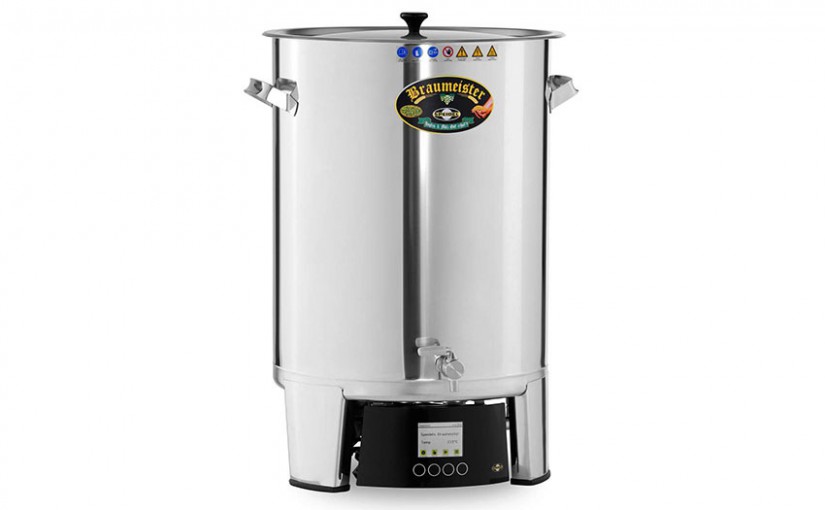

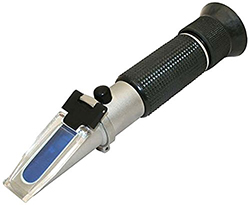


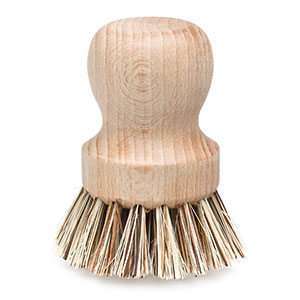

Thx for the extra info!
Nice work, thanks for sharing.
Hi
Why did you call the biscuits “dog treats”?they look tasty 🙂
Yeah, you can eat them, but the bone shape makes it look a bit weird!
exactly :-)))
Is the pump utilized during chilling? If so, is there any issue with hops clogging the pump? BTW, my system is on order through morebeer, can’t wait!
You don’t need to run the pump during chilling, it won’t add much circulation and will likely get clogged.
Why you say max capacity for Braumeister’s 20 malt pipe 6.8 Kg ? In the Speidel-Braumeister site they talk for max 6,0 Kg, and this more than 10% difference is serious
I never had problems brewing with up to 6.8kg, beyond that, you have to press the grain too much.
Most big beers require 6.8-7.0kg for 20L. That’s actually the one of the limitations of the Braumeister; you can tell it was originally designed with German beers in mind, but with big IPAs or any style that shoots for more than 7% alcohol, you reach the limits of the malt pipe.
If you want to stick to the recommended 6kg, just brew smaller batches and scale your recipes down using BeerSmith
Do you think that 3L sparging
water is enough ?
Yes, it’s enough, because it’s just to get some more sugars that may be stuck in the mash.
The Braumeister does not require any sparging, actually, because, technically, the the sparging is already done when you lift the pipe thanks to the pump and circulation.
So, I do a quick minimal sparge, just to get some more sugars.
Hello there.
I would like to buy this one, but I cannot find any information about whirlpool process. Does the Braumeiter 50l Plus has builded in whirlpool function? Does the bottom of the device have some slope or some other solution, so that after the whirlpool, minimum bruch falls into the fermenter?
Please some info!
The 50L Braumeister does not have a built-in whirlpool function and, as far as I’m aware of, neither do the 200 and 500L; you just have to do the whirlpool with a paddle.
Hi. I’ve definitely noticed a difference in the finished product when water is added late during the boil process, much better to estimate boil loss and add that amount of water through the sparge.
Very true.
All in all, once you know your equipment (evaporation, loss here and there, etc), you can very accurately predict the amount of packaged beer based on your pre-boil volume.
Disinfecting before brewing is unnecessary. Store the kettle in a clean and dry place after use. Rinse before starting if there is dirt. The malt is not clean either and doesn’t need to be disinfected.
I totally agree with this. I don’t sanitize the kettle before brewing. The boil does it anyway.